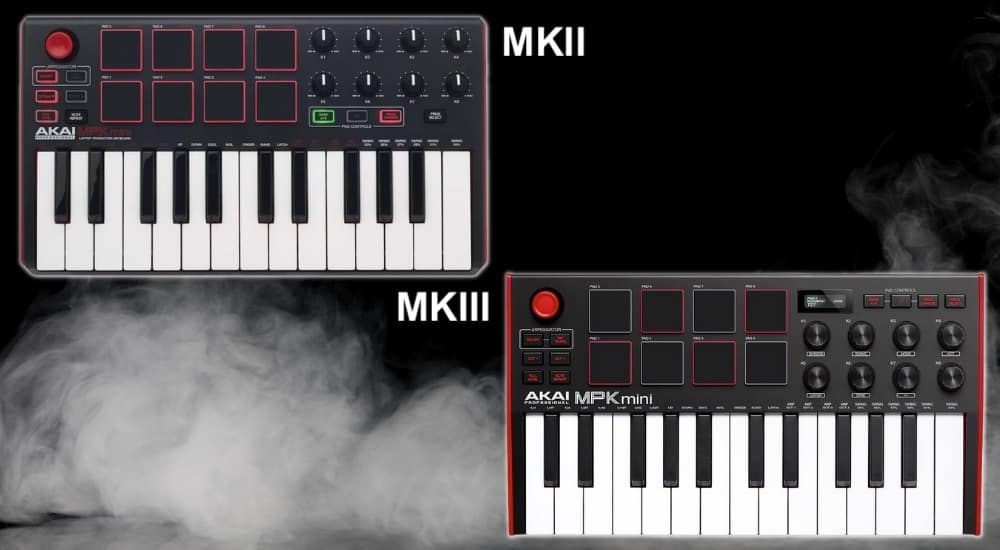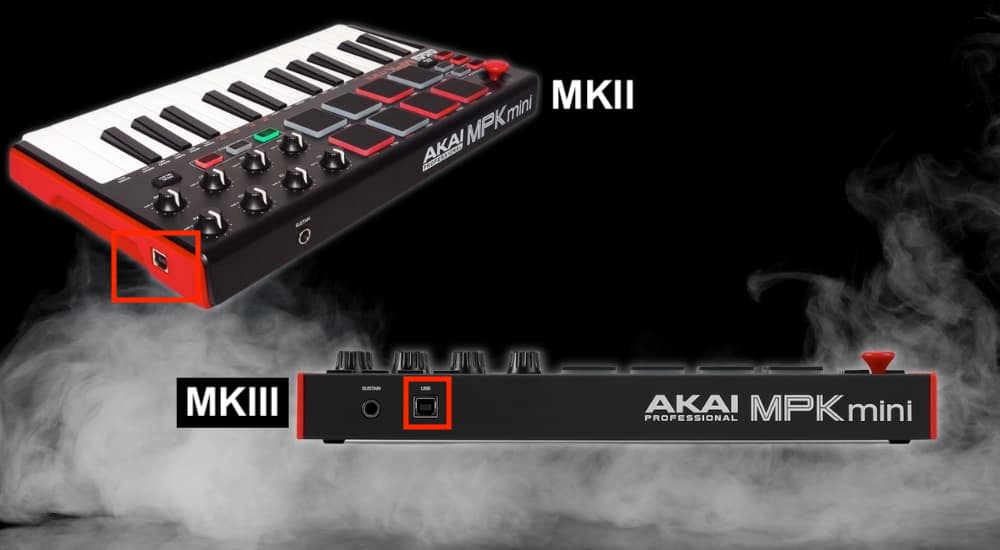A lot of competitors have flooded the market with their own rendition of the MPK Mini and many are quite good. The M-Audio Oxygen series is just one example of a competitor keyboard that’s right up there in terms of quality. This is probably why AKAI has upgraded the MKII to the MKIII.
The primary difference between the AKAI Mini MKIII and the MKII lies in the added LED screen, the endless encoder knobs, the improved key bed, moving the USB port to the back rather than the side, and the sturdier and more durable keys.
The Primary Difference Between the AKAI MK2 and the MK3
To put it simply, the AKAI MPK Mini MKIII is practically the same as the MKII but all of the components have been improved considerably so it seems more like an instrument rather than something you’d find on the playground.
It appears that AKAI chose the “if it’s not broken, don’t fix it”-method because they didn’t make many changes other than improving the integrity of the pre-existing features.

I’ve compiled all of the differences between the AKAI MKII and the MKIII in this chart here, that way you have a clear idea of how they’re separate.
Differences Between the AKAI Mini MPK MKII and the Mini MPK MKIII
| AKAI Mini MPK MKII | AKAI Mini MPK MKIII |
| Has stop-knobs | Endless encoder knobs (they continuously spin) |
| No LED screen | LED screen |
| USB port is on the side | USB port is on the back |
| flimsier keys | Keys are more sturdy, stable, and less “toy-like.” |
| MPC Pads | Upgraded MPC Pads that are thicker yet more sensitive |
| Cheaper | Slightly More Expensive |
| Less reliable customer support | Better customer support (because the device is newer) |
Each of these differences deserves a little bit of discussion separately, in my opinion, so let’s dive into each aspect a little bit more now.
Stop Knobs vs Endless Encoder Knobs
The AKAI MINI MKII has what some people like to call “stop-knobs,” although, I’m not entirely sure if they’re called that. The name indicates what they do, in the sense that there is a limit to how much you can turn each knob on the device.

Each knob stops at a certain point, whereas the MKIII features endless encoder knobs, which means you can turn them for however as long as you want or need to.
You can tell what changes you’ve made to the sound based on what you’re hearing but also through the LED screen. This is the same thing as my AKAI MPD 226 Drum Pad which I also wrote an article on.

What I like more about the endless encoder knobs is that they appear to be made out of some kind of metal rather than plastic and they’re generally much less flimsy. That’s the main advantage to them, compared to the stop-knobs that tend to have a more cheap-plastic vibe.
No LED Screen vs LED Screen

The added LED screen really just tells you, visually, what changes you’ve made to the various parameters of the device, although, not everyone actually likes this LED screen.
For instance, the guy over at Engadget says that it doesn’t help in any “meaningful way” and I have to agree with that sentiment because I’m not a bells-and-whistles type of person.
I appreciate the other improvements AKAI has made to their product here, notably, the improved knobs, pads, and keypad, rather than more features like an LED screen. I wasn’t a big fan of the self-tuning Gibson Les Paul that came out a few years ago either – similar bells-and-whistles-type vibe.
USB Port on the Side vs the Back

Another thing that AKAI has changed here is that the USB port is now on the back of the device rather than on the side of the device, which to me, is a serious improvement that seems trivial when first mentioned.
For one, most of us have our MIDI keyboards between speakers or other equipment – here’s how to connect your MIDI keyboard to your device by the way (as well as a video down below).
This means having the USB port on the side of the device means we need to make more space between the keyboard and the accessories sitting beside it. Really, having the USB port on the side of the device is a considerable design flaw in my opinion.
For instance, right now my M-Audio Oxygen Pro Series 61 (on my Product Page) is sitting right between my iLoud Micro Monitors (also on my Page), and if it had the USB port on the side, I would have to put my speakers somewhere else because the USB cable would be in the way.
Sturdier Keys

This one’s harder to illustrate with pictures, but the difference must be stated because really I think it’s one of the more important improvements that AKAI has made to their MKIII keyboard.
The fact of the matter is that keys are just way better, they feel better, they look better, and they have less of that cheap-plastic feel.
This is great if you’re serious about creating melodies with your keyboard (PianoForAll – on their site – is great for learning how to do this).
I really appreciate when manufacturers avoid using plastic where they can because oftentimes it ends up making the product seem like junk rather than anything good.
Don’t get me wrong, I love the iRig HD 2 (on my Page) and I’ve recommended it in my article on guitar audio interfaces, but if it were made out of steel, it would be a 10/10 product rather than just an 8/10.
Price Difference
Another difference that must be mentioned between the MKII and the MKII is the price. You can check the price of the two models – the AKAI MKII and the MKIII.
I can’t say what the prices are here directly because I don’t want to be banned from their affiliate program (it’s one of their terms and conditions).
More Reliable Customer Support

And finally, the last difference that’s worth a short excerpt is the customer support. This could probably be said about many different products and manufacturers but I think it’s important to say anyway.
Because the AKAI MPK Mini MKIII is newer, it means you’ll likely get better customer support in case you need it.
Companies tend to be a lot nicer to people who have bought their latest model rather than those of us who have stuck to much older products. Maybe they want to be nicer to newer customers, who knows, it’s hard to say what their reasoning is for that.
Similarities Between the AKAI Mini MPK MKII and the Mini MPK MKIII
Much of the features are fundamentally the same on the MKII and the MKIII, including the 8 drum pads, 8 volume knobs, X-Y Joystick, the arpeggiator, and note-repeat function, and the velocity-sensitive keys. The AKAI MKIII also uses the same MPC Beats software as the MKII.
Is the AKAI MK2 or MK3 Worth It?
The AKAI MPK Mini MKIII is definitely worth getting if you’re in the market for a budget-friendly midi keyboard that’s packed with features. It’s best to just get the newer one because a lot of the components and features have been upgraded, improved, and more pleasant to use. That said, you could get the MKII and save a bit of money.
Important Things to Note About the AKAI MK2 and MK3
1) They Use the Same MPC Beatmaking Software
As I said earlier, the AKAI MKIII and the MKII use the same software so no worries there.
Gear Mentioned
1) Akai Mini MPK MKIII
2) Akai Mini MPK MKII
3) iLoud Micro Monitors
4) iRig HD 2
5) Arturia KeyLab 61 MKII


 Written By :
Written By : 